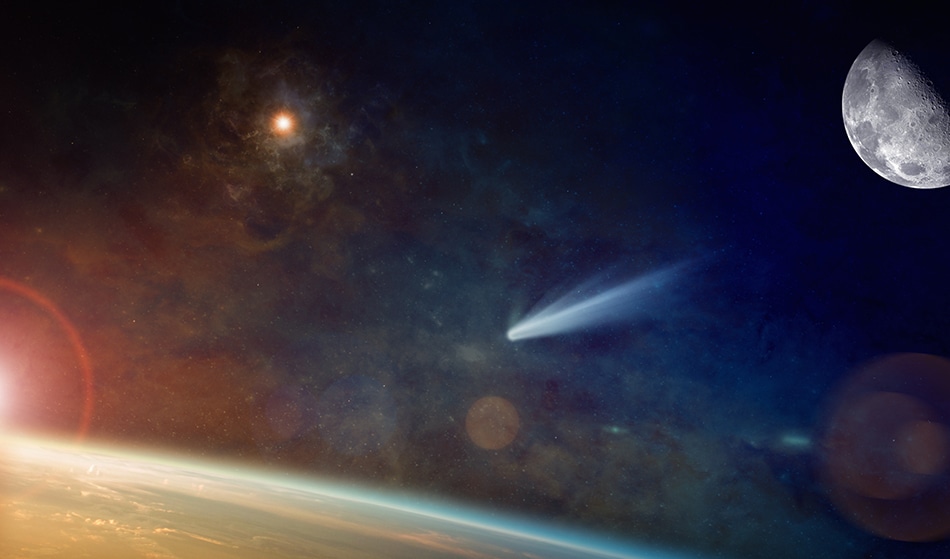Dust collected from the comet 67P / Churyumov-Gerasimenko between August 2014 and September 2016 has indicated the comet’s formation happened around the same time as the formation of our Solar System, according to a new report in the Monthly Notices of the Royal Astronomical Society.
The European Space Agency launched the Rosetta probe to study the comet, also known as Tchouri, as it made its way into the center of the Solar System. The ROSINA instrument onboard Rosetta allowed scientists to study the gases released by the comet as it approached the sun.
Realizing that gases represent just a small portion of the comet’s overall matter, the scientists also looked to investigate grains of dust that were released, as they are more representative samples of its make-up. Moreover, the dusts’ chemical characteristics can indicate those of the comet's nucleus.
Rosetta scientists used a physicochemical mini-laboratory called the COSIMA instrument to collect, photograph and measure dust grain released by Tchouri, using a method called “mass spectrometry of secondary ionization coupled with flying time (TOF-SIMS)”. During the two years around the comet, COSIMA collected the kind of data that was unforeseen by the scientists and engineers who designed it around two decades ago. The instrument collected more than 35,000 particles that measured are up to 1 millimeter across.
"We expected much less, and infinitely smaller,” the study authors said in a news release.
 Image credit: Igor Zh/shutterstock
Image credit: Igor Zh/shutterstock
The scientists looked at approximately 250 kinds of particles by mass spectrometry. From these assessments, the study team could then calculate the fundamental composition of these dust grains, along with some data on the chemical nature of some components. The team found that each cometary dust particle held an average of 50 percent carbonaceous matter. This matter was comprised of relatively large structures that were completely disordered, random and intricate. The other 50 percent of the mass was primarily made up of non-hydrated silicate minerals.
The study team found the composition of cometary dusts was not dependent on their size, shape nor when the dust was released; before or after the comet approached the Sun. The particles examined were found to be small fragments of the nucleus, coming from its exterior and abysses that go deep into the comet. The team said finding based on COSIMA likely reflect the true overall composition of the comet nucleus, a 50-50 blend of minerals and carbonaceous material.
The COSIMA measurements, coupled with observations from other Rosetta instruments, revealed that most cometary carbonaceous material cannot be analyzed using its ice and gas, but can be analyzed using its dust. This outcome corresponded to the laboratory analyses of extra-terrestrial materials found on Earth, including meteorites and interplanetary dust particles. However, this study is distinctive in the source of extra-terrestrial materials discovered in Earth is rarely known. Moreover, heating during the atmospheric re-entry alters and modifies the make-up of these materials. The in-situ measurements of COSIMA and the dust being collected at low speed meant the chemical information had been conserved.
The study team said their results prove that comets are among the most carbon-rich items in the Solar System. Also, the abundance ratio between carbon and silicon identified in the study is very close to the measured on the exterior of the Sun. Moreover, the silicates seen in the dust of Tchouri do not show any traces of modification by liquid water. These two findings clearly indicate the ancient character of this cometary substance, the researchers said.
The study team discovered that material from the comet has hardly been transformed or modified after the formation of the comet, at the beginning of the Solar System almost 4.5 billion years ago. The scientists also said that if comets like Tchouri played a part in the appearance of Life on Earth by bringing carbon-rich matter, it is in this intricate macromolecular form that it will have been basically brought there.
Disclaimer: The views expressed here are those of the author expressed in their private capacity and do not necessarily represent the views of AZoM.com Limited T/A AZoNetwork the owner and operator of this website. This disclaimer forms part of the Terms and conditions of use of this website.